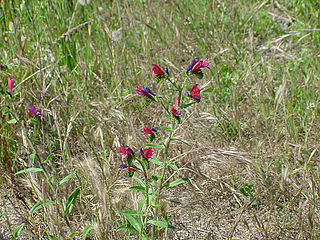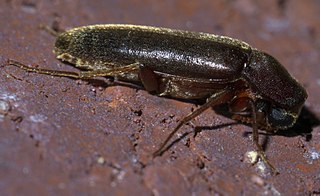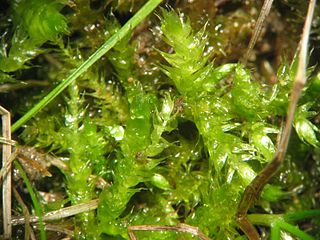
Echium creticum, the Cretan viper's bugloss, is a species of flowering plant in the family Boraginaceae. It is native to the western Mediterranean Basin. It is also used as an ornamental plant.
British NVC community OV41 is one of the open habitat communities in the British National Vegetation Classification system. It is one of six communities of crevice, scree and spoil vegetation.
British NVC community OV39 is one of the open habitat communities in the British National Vegetation Classification system. It is one of six communities of crevice, scree and spoil vegetation.
Geranium sericeum is a species of plant in the family Geraniaceae. It is endemic to Ecuador. Its natural habitat is subtropical or tropical high-altitude grassland.

Gastrolobium sericeum is a flowering plant in the family Fabaceae. It is endemic to the south-west of Western Australia. It is a prostrate, low shrub with pendulous yellow, green, red or nearly black pea-flowers from spring to summer.

Symphyotrichum sericeum is a species of flowering plant in the family Asteraceae native to central North America. Commonly known as western silver aster, western silvery aster, and silky aster, it is a perennial, herbaceous plant that may reach 70 centimeters tall. Its flowers have purple ray florets and pink then purple disk florets, and its leaves are firm and silvery-green.

Calopogonium is a genus of flowering plants in the legume family, Fabaceae. It includes eight species, which range through the tropical Americas from Mexico through Central America, the Caribbean, and northern South America to northeastern Argentina. It belongs to the subfamily Faboideae.

Ribes sericeum is a species of currant known by the common name Lucia gooseberry, or Santa Lucia gooseberry; its Latin epithet of sericeum means "of silk". It is endemic to California, where it is known only from the Santa Lucia Mountains along the Central Coast and an additional isolated population in Santa Barbara County.

Bryotropha desertella is a moth of the family Gelechiidae. It is found in most of Europe, North Africa (Morocco), Turkey, Turkmenistan and the Russian Far East.
Bryotropha dryadella is a moth of the family Gelechiidae. It is found in Great Britain, France, Portugal, Spain, Corsica, Sardinia, Sicily, Italy, Albania, North Macedonia, Bulgaria, Greece, Crete and Algeria.

Bryotropha senectella is a moth of the family Gelechiidae. It is found throughout Europe.
Palaquium sericeum is a tree in the family Sapotaceae. The specific epithet sericeum means "silky", referring to the indumentum.

Leptospermum sericeum, commonly known as the silver tea tree, is a species of shrub that is endemic to the south-west of Western Australia. It has thin, firm bark, egg-shaped leaves with the narrower end towards the base, relatively large, pink flowers and fruit that fall from the plant with the seeds. It grows in windswept rock crevices near Esperance.

Melittomma sericeum, the chestnut timberworm, is a species of ship-timber beetle in the family Lymexylidae. It is found in North America.
Priobium sericeum, the silky anobiid, is a species of death-watch beetle in the family Ptinidae. It is found in North America.

Brachytheciaceae is a family of mosses from the order Hypnales. The family includes over 40 genera and 250 species.

Homalothecium is a genus of mosses belonging to the family Brachytheciaceae.
Aframomum sericeum is a species of plant in the ginger family, Zingiberaceae. It was first described by Jean-Baptiste Dhetchuvi and David J. Harris.
Leucadendron sericeum, the Wabooms conebush, is a flower-bearing shrub belonging to the genus Leucadendron and forms part of the fynbos. The plant is native to the Western Cape, South Africa.











